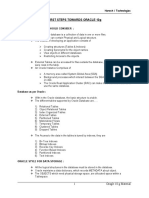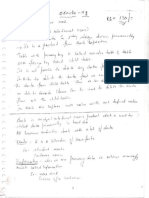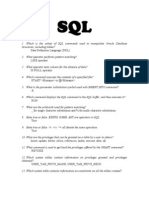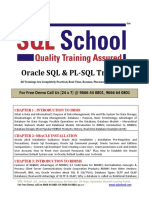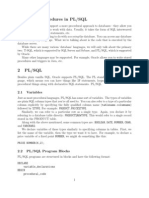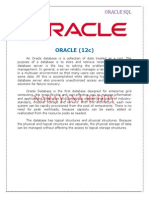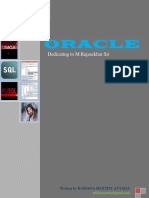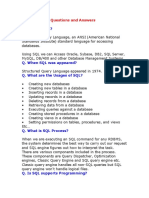0 ratings0% found this document useful (0 votes)
344 views246 pagesKrishna Reddy (Oracle 11g)
The document provides an overview of databases and database management systems (DBMS), explaining their definitions, types, and functionalities. It details various database models including File Management Systems, Hierarchical Database Systems, Network Database Systems, and Relational Database Management Systems (RDBMS), highlighting their advantages and disadvantages. Additionally, it covers the structure and components of SQL, Oracle architecture, and essential processes involved in database management.
Uploaded by
rameshtharu076Copyright
© © All Rights Reserved
We take content rights seriously. If you suspect this is your content, claim it here.
Available Formats
Download as PDF or read online on Scribd
0 ratings0% found this document useful (0 votes)
344 views246 pagesKrishna Reddy (Oracle 11g)
The document provides an overview of databases and database management systems (DBMS), explaining their definitions, types, and functionalities. It details various database models including File Management Systems, Hierarchical Database Systems, Network Database Systems, and Relational Database Management Systems (RDBMS), highlighting their advantages and disadvantages. Additionally, it covers the structure and components of SQL, Oracle architecture, and essential processes involved in database management.
Uploaded by
rameshtharu076Copyright
© © All Rights Reserved
We take content rights seriously. If you suspect this is your content, claim it here.
Available Formats
Download as PDF or read online on Scribd
You are on page 1/ 246
Gpp. Satyam Theatre, technologies
Ameerpet, Hyderabad - 500 016. ssenmaie TRAINING BERENS ENT
E-mail:info@nareshit.com www.nareshit.com
Ph:23746666, 23734842 Cell: 9000994007, 3000994008
Oracle 11g Material
——————————
fhat is Database Actually?
Database is a platform where we can place the data fro the future references.
Database is a collection of interrelated data, i.e. database always stores data along with
's relationships.
What js Database Management System?
‘A database Management System is essentially a collection interrelated data and a
set of programs to access this data, This collection of data is called the Database. The
primary objective of a DBMS is to provide a convenient environment to retrieve and
store database information. Database System support single user and multi-user
environment. While on one hand DBMS permits only one person to access the database
at a given time, on the other RDBMS allows many users simultaneous access to the
database.
‘A Database System consists of two parts namely, Database Management System and
Database Application. Database Management System is the program that organizes and
maintains the information whereas the Database Applications is the program that lets us
view, retrieve and update information stored in the DBMS.
+ Database is a collection of data in one or more files for the future reference,
* Database is a collection of interrelated data, i.e. database always stores data
along with it’s relationships.
Database Modeis:
The main object'of the database is store the inter related data and maintain the
data. The very basic elementary piece of data is called as ‘data item'.we assume that
item cannot be subdivided into smaller data types and at the same time retain any
meaning to the users of the data. The relationship among the data items, which shows
how they are related, is called as Data model’.
The database models are
1. File Management System(FMS)
2. Hierarchicla database System(HOS)
3. Network database System(NDS)
4, Relational database Management System (RDBMS).
File Management System:
The File Management System was the first method used to store data in a
computerized database, Each data item is stored on disk sequentially in one large file. In
order to locate one particular item the search starts at the beginning and each item
checked subsequently till the match is found.A particular relationship cannot be drawn
between the items other than the sequence in which it is stored.
Drawbacks:
+ A particular record can not be located quickly. If the data has be stored, the
whole file has to be read and rewritten in the new order,
Tt will not support data types.
It will not support to store or allocate memory dynamically,
Data con not be shared with concurrent users.
Data duplication.
Very poor security: Operating system provide only a password mechanism for
security, This is not sufficiently flexible to enforce security polices in which
different users have permission to access different subsets of the data
* Retrieving data from a file is not faster: We have to write special pragrams
to answer each question a user may want to ask about the data, These programs
are likely te be complex because of the large volume of data to be searched.
Naresh i Technologies, Opp. Satyam Theatre, Anieerpet, Hyderabad, Ph: 23746666, 9000994008
Oracle 11g Material
Hierarchical Database System(HDS):
as
Dent bag [on]
(ioe | (amr (Cien ][om ] [Tn
| I L
aim fo own fof ae | waa Jol oe Jo ooo]
Fig 1.
Data storage is in form of a parent-child relationship.The origin of a data tree is
the root,Data located at different levels along a particular branch from the root is called
the node.The last node in the series is called the leaf.This model supports One-to-Many
relationship.From the figure 1.0 it can be seen that the nodes in the third level are
interrelated.Each child has pointer to nuierous and there is just one pointer to the
parent thus resulting in a One-to-Many relationship.
Suppose an information is required ,say ID 3.1, it is not necessary for the DBMS
to search the entire file to locate the data.Insted, it first follows the Dept3 branch and
fetches the data.
Disadvantages:
Tt Is not possible to enter a new level into the system. As and when such a need
arises the entire structure has to be revamped. Another disadvantage is that this model
does not support Many-to-Many relationship. In case this sort of relation is required
then multiple copies of the same data have to made which result in redundancy. To
overcome this drawback, tive Network Database Model was introduced.
Note: The terminal points shows, for example below ID. 1.n.indicate that similar data are
present at that point.
Network Database Systems(NDS'
The main idea behind the NDS model is to bring about Many-to_Many
relationship. The relationship between the different data items is called as sets. This
system also uses a pointer to locate a particular record(i.c called as Physical Links)
Disadvantages:
‘The use of pointers leads to complexity in the structure, As a result of the
increased complexity mapping of related data become very difficult.
Relational Mode(RDBMS):-
+ The Model was first outlined by E.F Codd 1970,
+ The Components of Relation Model are:
© Collection of objects or relations that stores the data
© Aset of operations that can act on the relations to produce other
relations.
+ Data integrity for accuracy and consistency.
+ Ithas only logical representations.( i.e in the form of table(rows and
columns.)
* Intersection of rows and columns gives single value.
Naresh I Technologies, Opp. Satyam Theatre, Ameerpet, Hyderabad, Ph: 23746666, 9000994008
. Oracle 11g Material
No data redundancy .
No physical link relations are maintain logicaliy.
Supports NULL values, integrity constraints.
Provides high security.
Supports unlimited size.
supports to store any data types (number characters date,
images audio text files.)
Data can be stored among several users at time.
* Data can also be shared across several plot forms.
* Oracle 10g is proven to be the fastest database for Transaction processing
Datawarehousing, and third party applications on servers of all sizes,
+ Use of Flashback Queries
Alt queries the database by TIME or user specified SCN (System Change
Number).
2)It uses Oracle's multi version read-consistency capabilities to restore data
by applying
UNDO as needed
ENTITY RELATIONSHIP Model:
« Inan effective system data is divided into discrete categories or entities.
‘An ER-Model is an illustration of various entities in a business and the
relationships beti-een them.
+ ICs built during the analysis phase of the System Developing Life Cycle.
* ER-Model separates the information required & the business from the activities
performed.
ER-MODEL Benefit:
‘It document information for the organization in a clear, precise format.
* Provides a clear picture of the scope of the information requirement.
+ Provides an easily understood pictorial map for the database design.
+ Itoffers an effective framework for integrating multiple application.
Key Components in ER-MODEL:
* ENTITY: It is a thing of significance about which the information need to be
know.
+ ATTRIBUTES: It is something that describes or qualifies an entity.
¥* Each attribute may be mandatory or optional but one attribute Mandatory.
Relation among dat:
+ Arelationship is defined as “an association among entities.
+ Arelationship type is an association of entity types.
+ Several relationships may exist between the same entity.
The three different types of relationships recognized among various data stored in
the database are:
© One-to One
+ Qne-to Many(or Many-to-One)
+ Many-to-Many
‘Naresh i Technologies, Opp. Satyam Theatre, Ameetpet, Hyderabad, Ph: 23746666, 9000994008
One-to-One:
* Consider for example a set of students in a class. Each student can only one roll
number. Similarly, each roll number can be associated only with one student,
This is the case of One-to-One relationship Fig 1.2 illustrates this
relationship.
Student 1 ot Assigned > Rotlno 1
Student 2 Rollno 2
Many-to-One:
One student can register for only one particular course at a time, where a number of
students could register for the same course,
This is illustrated with Fig1.3
Students |.
Student2 Register Course
Student 3 :
ig 1.3
Many-to Many:
A vendor can sell a number of items and many vendors can sell particular iter. This
can be understand from Fig 1.4 given below.
Vendor 1 Item 1
Vendor 2 Item 2
Fig 1.4
Relation Database Terminology:
Row or Tuple
+ Terepresents all data required for a particular instance in entity,
+ Each row is an entity is uniquely identified by declaring it has PRIMARY KEY or
UNIQUE.
+ The order of the rows is not significant, while retrieving the data.
Column Or Attribute:
«It represent one kind of data in a table.
+ The column order is not significant when storing the data.
A Field:
«It can be found at the Intersection of row and a column.
+ Afield can have only one value, or may not have a value at all, the al-ence of
value in Oracle is represented as NULL.
Relating Multiple Tables:
‘* Each table contains data that describes exactly only one entity.
* Data about different entities is stored in different tables.
* RDBMS enables the data in one table to be related to another table b* sing the
Foreign keys.
+ AForeign Key is a column or a set of Column that refer to a Primary |. «in the
same table or another table,
Rational Database Properties:
‘+ Should not specify the access route to the tables, and should not rev-» he
physical arrange.
Naresh i Technologies, Opp. Satyam Theatre, Ameerpet, Hyderabad, Phi 23746666, 90°: 4008
"Oracle 11g Matertat
—— eee ee
«The Database is accessed using Structured Query Language(SQL)
+ The language is a collection of set operators.
Communicating Wit! MS:
+ The Structured Query Language is used to Communicate with RDBMS.
Structure Query Language:
‘* Structure Query Language and commonly pronounced, as “SEQUEL”
(Structured English Query Language)
* Dr E.f Codd published the paper on relational database model in June 1970.
IBM Corporation , Inc.
SEQUEL later become SQL.
allows the user to communicate as the server.
It is easy to learn and use.
It is functionally complete, by allowing the use to define, retrieve and
manipulate the data.
Components of SQL:
* Oracle SQL Complies with industry accepted standards.
* The SQL Contains 5 Sub Language.
zeData Retrieval/ Query Language( DRL/DQL)
SELECT
‘* It used to retrieve the information from database objects for read only
purpose,
4 Data Manipulation Language(DML).
«It used to manipulate the data in database objects
INSERT(new content) UPDATE(modify)
DELETE(remove)
24Data Definition Language(DDL)
«Used to define database objects
creation
modification
removing
CREATE = ALTER DROP TRUNCATE = RENAME
x Data Control Language(DCL)
* It used to share the information between users
GRANT(give) REVOKE(cancel)
© Transaction Control Language(TCL)
"It used to save or cancel DML operations
COMMIT ROLLBACK SAVEPOINT
Naresh i Technologies, Opp. Satyam Theatre, Ameerpet, Hyderabad, Phi: 23746666, 9000994008 -5 -
Oracte Lig Material
Oracle Architecture:
User SQL * Net nnn
Processes | Listener Multithreaded Server
=I
Shared Pool System Global Area |
Program Global Area
Private
To distributed database nodes
RECO
. icen | [ ucwe__|[__cxer DBWR
SHON
nrchive
Destination
a
("seco |
bogs j [Datat.dbf |
ing redologs = * | ee
[men Data abr
Init.org Controt File | [>
el 7
Fig 4.1
User Processes
© When a user runs an application program, such as a Pro*C program, or an Oracle
tool, such as Server Manager, Oracle creates a user process to run the user's
application.
-->user process will create in client side.
-->SQL * Net Listener will run on server for particular port.
--> Listener will listen for incoming request and service the request.(it will create a
server process on server?)
Dispatcher Processes(Dnnn).
+ The Dispatcher processes allow user processes to share a limited number of
server processes.
+ Without a dispatcher, each user process requires one dedicated server process.
Multithreaded Server(Shared server)
> In dedicated server architecture each user process will create a Server process on
the server where as in shared server architecture each server process will be shared by
multiple user process.
Naresh i Technologies, Opp. Satyam Theatre, Ameerpet, Hyderabad, Ph: 23746666, 9000994008
Oracte 11g Material
—— ee
Oracle SGA(System Global Area):
* Oracle allocates @ memory area called the System Global Area(SGA) and starts
‘one or more Orarle processes.
* A System Global Area(SGA) is group of shared memory structures that contain
data and control information for one Oracle database instance,
+ Note: The combination of SGA and the Oracle processes is called an Oracle
database instance.
* The SGA, consists of several elements.
Buffer Cache:
‘+ The buffer cache stores Oracle data in memory for users to view or change .In
this way, user never make changes directly to disk files.
Redo Log Buffer:
* The log buffer stores special information called redo, which helps oracle
reconstruct data changes in the event of system failure.
Shared Poot
+ Components of the shared pool include the library cache, for storing parsed SQL
statements for reuse by other users.
Library Cache
‘The library cache includes shared SQL areas, private SQL areas, PL/SQL
procedures and packages, and control structures such as locks and library cache
handles.
Dictionary Cache
+ The data Dictionary is a collection of database tables and views ,and its users.
Data Dictionary stores
Names of all tables and views in the database
>Names and data types of columns in database tables
> Privileges of all oracles users.
Server Processes:
«Server process created on behalf of each user’s application may perform one or
more of the following:
© Parse and execute SQL statements issued via the application.
© Read necessary data blocks form disk(datafiles) into the shared database
buffers of the SGA, if the blocks are not already presents in the SGA,
Background Processes
The background processes in an Oracle instance include the following
Lock(LCKn)
‘+ With the parallel Server option, up to ten Lock processes(LCK0,....LCK9) provide
inter-instance lacking. However, a single LCK process(LCK0) is sufficient for most
Parallel Server Systems.
Database Writer(DBWR_
+ Database Writer process writes buffers to datafiles.
+ The primary job of the DBWR process is to keep the buffer cache “clean” by
writing dirty buffers to disk.
Log Writer Process(LGWR)
+ The Log Writer Process(LGWR) writer the redo log buffer to a redo fog file an disk,
* LGWR writes one contiguous portion of the buffer to disk, LGWR writes a commit
record when a user process commits a transaction.
Recoverer Process(RECO)
* The Recoverer process(RECO) is a process used with the distributed option that
automatically resolves failures involving distributed transactions.
* The remote server is not available or the network connection has not been re-
established ,RECO automatically tries to connect again a timed interval.
Checkpoint Process(CKPT)
* When a checkpoint occurs, Oracle must update the headers of all datafiles vo
record the details of the checkpoint, This is done by CKPT.
Naresh i Technologies, Opp. Satyam Theatre, Ameerpet, Hyderabad, Ph: 23746666, 9000994008 -7 -
Oracle Hg Material
Cee
Process Monit IN):
‘+ The process Monitor (PMON) performs process recovery when a user process
fails.
+ PMON is responsible for cleaning up the cache and freeing resources that the
process was using
Ex; It resets the status of the active transaction table, release locks.
Snapshot Refresh Processes(Snpn)
+ With the distributed option, up to ten Snapshot Refresh processes(SNPO,...SNP9)
can automatically refresh table snapshots.
+ These processes wake up periodically and reftesh any snapshots that are
scheduled to be automatically refreshed.
‘System Monitor(SMON)
* The System Monitor. process(SMON) performs instance recovery at instance start
up.
+ SMON is also responsible for cleaning up temporary segments that are no longer
in use.
Datafites.
«This mandatory disk components is used for storing oracle dictionary and
application database object.
* Datafiles stores Oracle data.
* Each datafile can be associated with only ane database.
Redo Logs .
‘+ This mandatory disk components is used for storing redo infermation on disk.
{ic rollback segment data).
Control file
+ The Physical locations of both datafiles and redo logs in the server's files system
are stored in your control files.
Parameter Files(init.ora’
+ This mandatory disk components is used for configuring how oracle operates
while it is running .
Sql * Plus Buffer:
+ SQL * Plus ORACLE has developed it’s environment tool.
We can use directly SQL & PL/SQL statements in this environment tool.
All commands of SQL are typed at the SQL prompt.
Only one SQL Statement is managed in the SQL Buffer.
The Current SQL statement replaces the previous SQL statement in the
Buffer.
+ SQL statement can be divided into different lines within the SQL Buffer.
* Only one line i,e., the current line can be active at a time in the SQL
Buffer.
+ At SQL prompt, editing is possible only in the current SQL Buffer tine.
+ Every statement of SQL should be terminated Using(;}.
+ To run the previous or current SQL statement in the Buffer type’ at
SQI. prompt.
+ To open the SQL Editor type ed at SQL prompt.
* It provides.
© SQL commands
© PL/SQL block ‘i
© It has own commands to set environment as reautirement.
© To generate report.
© To save SQL command as file(.sql)
© Tosave PL/SQL command as file(.sq])
© To save output as file(.Ist)
Naresh i Teeluologies, Opp. Satyom Theatre, Ameerpet, Hyderabad, Ph: 23746666, 9900994008
y Oracle Lig Material
reatin« Managing Tables:
"A Oracle database can contain multiple data structures.
«The different Database objects in Oracle are:
TABLE: Used to store data, Sasic Unit
VIEW: Logically represent subsets of data from one or more tables.
‘SEQUENCE: Used to Generate Primary Key values.
INDEX: It is used to improve the performance of some queries.
SYNONYM: Used to give alternate names to objects.
Table in Oracle:
+ Table can be crated at any time, even when the users are using the database.
«Size of the table need not be specified.
For create table:
1)Table Name 2)Column Name 3)Data Type
Table Restriction:
+ The user should have permission or CREATE TABLE command, and storage
area,
+ Table name must be unique in schema
«The Table name should begin with a letter and can be 1-30 characters long
+ Maximum 1000 calumns(8.0), 256 in 7.x
* Names can contain:
eA Z a — 2 0-9 $F
+ Names can not be duplicated for another object in the same ORACLE Server.
«Name cannot be oracle server reserved words.
* Names are not case sensitive,
COLUMN NAME:
~The column name should begin with a letter and can be 1-30 characters long,
+ Column name is Unique in a table.
+ Column name can be renamed,
+ Maximum columns in table is 1000.
Data Types in Oracle:
* Each value in ORACLE is manipulated by a data type,
+ The values of one data type are different from another data type.
‘+ The data type defines the domain of values that each column can contain.
"The Built-in-data types af ORACLE are Categorized as
CHARACTER Data Types
NUMBER Data Types
LONG and RAW Data Types
DATETIME Data Types
ROWID Data Types
Character Data Type:
‘They store character data which can Alphanumeric data.
* The Information can be
© Words
Database Character set
© National Character set
They are less restrictive than other data types an have very few properties,
+ They data is stored in strings with byte values
+ The different character data types are:
CHAR NCHARVARCHAR VARCHAR2 NVARCHAR2
Naresh i Technologies, Opp. Satyam Theatre, Ameerpet, Hyderabad, Ph: 23746666, 9000994008» 9-
Oracte Lig Material
Dai t
* It specifies fixed length character string.
"The size should be specified.
* If the data is less than the original size, blank pads are applied.
* The default length is 1 Byte and the Maximum is 2000 Bytes.
NCHAR Data Type:
"Its first defined in ORACLE 9i, and contains Unicode data only.
* The column's maximum length is determined by the National Character set
definition.
* The Maximum size allowed is 2000 Bytes and size has to be specified.
* If the data short than the actual size then the blank pads are applied
Varchar2 Data Type: -
* A data type used for storing text data.
+ The Minimum size is 1 Byte and the Maximum size is 4000 Bytes.
+ It occupies only that space for which the data is supplied.
+ Any text character (including special characters, number, dashes, and so on) can
be stored.
Iv 2 Data Type:
«tis first defined in ORACLE 9i, and contains Unicode data only,
+ The Minimum size is 1 Byte and the Maximum size is 4000 Bytes.
Number Data Type:
Number(Precision, Scale)
+ Number data type stores the numeric data, the precision is the total nc of digits
required and scale stands for the rounding of decimal place.
+ Range of precision is from 1 to 38.
+ Range of Scale is -84 to 127.
Integer Data Type:
* Integer data type will converted as Number Data type with the maxim size 38
digit as precision .
LONG:
"This data type is used to store characters or numbers.
+ Maximum size limit is 2 GB.
* only one Long column is valid per table.
Date & Time Data Type:
«Its used to store dates and time information.
+ The information revealed by date is:
*Century —*Year *Month
*Date *Hour *Minute — *Second
«The default date format in ORACLE is DD-MON-YY.
+ The default time accepted by ORACLE date is 12:00:00 AM(Midni:ht),
* The default date accept by ORACLE data is the First day of the Current
month,
+ The Date range provide by Oracle is
JANUARY 1,4712 BC to DECEMBER 31,9999 AD,
estamp Date Type:
+ Itis an extension of the DATE data type.
+ Ttstores
*Day *Month = *Year = *Hour *Minute . —*Seco nd
Naresh i Technologies, Opp. Saiyam Theatre, Ameerpet, Hyderabad, Ph: 23746666, 9000994008 - 10-
Oracle Lig Material
Syntax: TIMESTAMP(Fraciional-Seconds-Preci
«Fractional -Seconds-Precision optional specifies the number of digits in the.
fractional part of the SECOND datetime field,
«= Itcan be a number in the range of 0-9, with default as 6.
It stores binary information like Photos, Signature, Thumb impressions ect.
Maximum length is 2000 Bytes.
‘The Oracle converts the RAW and LONG RAW data into Hexadecimal form.
Each Hexadecimal character represent four bites of RAW data.
+ It stores the binary data similar to RAW but can store-more bytes than
RAW,
+ Maximum length is 268.
"No size is required.
Large Object(LOB) Data Types:
The Built in LOB data types are
*BLOB *cLoB *NCLOB
+ These data types are stored inerally.
+ The Bfile is an LOB which is stored externally.
‘+ The LOB data type can store large and unstructured data like Text, Image, Video
and Spatial deta.
© The maximum size is upto 4GB.
* LOB columns contains LOB locators, Which can refer to out-of-line to or in-line
LOB values.
+ _LOB's selection actually return the LOB’s locator.
BEILE Data Typ
+ Ttenables access to binary file LOB's which are stored in the systems outside
ORACLE.
+ A BFILE column or the attributes stores the BFILE locator.
+ The BFILE locator maintains the directary alias and the filename.
‘+ The Binary File LOB’s do not participate in transaction and are not recaverable.
+ The maximum size is 4 GB.
BLOB Data Type:
+ It stored unstructured Binary Large Objects,
+ They are Bit streams with no character set semantics.
‘+ They are provide with full transactional support.
CLOB Data Type:
+ It Dynamic data type.
+ They are provide with full transactional support.
+ The maximum size is 4 GB.
NCLOB Data Type:
+ Ie stores Unicode data using the National Character set
ROWID Data Type:
* Each row in the database has as address.
+ The rows address can be queried using the pseudo column ROWID.
+ ROWIO's efficient support partitioned table and Indexes.
Codd’s Rules:-
Dr E.F.CODD’s listed 12 rules for relational databases In 1985.
1, The Relational data base management rule:
+ Arelational data base management system must use Only its relational
capabilities to manage the information stared in the database.
2. The Information rule:
* All information in relational database must be represented as values within
columns in rows.
+ Pointers are variables that contain address of the memory location where the
data is stored.
‘Naresh i Technologies, Opp. Satyam Theatre, Ameerpet, Hyderabad, Ph: 23746666, 9000994008. - 11 -
Oracle 11g Material
3, The Guaranteed Access rule:
+ Every item of data must be logically addressable with tne help of a table name,
primary key value and column name.
4. The Systematic Treatment of NULL value rule:
+ Arelational database must support the NULL value for representing missing or
inapplicable data.
5. The Dynamic On-line catalog Based on the Relational Model Rule:
«The structure of the data base should be represented at Logical level in a tabular
form.
+ The representation of database structure as a collection of tables is known as
catalog or data dictionary.
6, The_Comprehensive Data sublanguage rule:
* An RDBMS support at least one clearly defined language that can be used
interactively as well as can be embedded in programs.(SQL).
7. The view updating rule:
* All theoretically updatable views must be updatable in table.
8. The High-Level insert Update and delete rule:
+” The date retrieval from a relational database must be possible in sets that may
comprise data from multiple rows or multiple tables.
The physical Data Independence rule:
+ The database user need not known about the physical Implementation of data
storage and retrieval. 7
10. The Logical Data Independence rule:
+” The data base user's view of a data should not be effected by any change in the
database tables.(Materialized view).
11, The Integrity Independence rule:
+. Data integrity rules must be defendable in the relational database and should be
stored in data dictionary,
12. The Distribution Independence rule:
+ The system must be able to access or manipulate the data that is distributed in
other systems.
13. Non-subversion Rule:
* If a database management system has a low level language, then it cannot be
used to violate the integrity rules or constrains that have been expressed using a
higher-level language.
To Create Table:
Syntax:
Sql>Create Table
(


